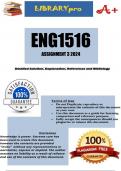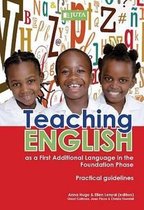ENG1516
ASSIGNMENT 3 2024
, lOMoARcPSD|21997160
2
ENG1516
ASSIGNMENT 3: Promoting a reading culture in a classroom.
This assignment is based on Units 5 and 6 in Tutorial Letter 501. It is important that
you work through these two units (as well as pages 129–156 and 177–198 of the
prescribed textbook, Introducing Children’s Literature: A Guide to the South African
Classroom (2017) by Evans, et al.) before you attempt this assignment. Answer the
questions below in full sentences.
Question 1
1.1 In your own words, define rhyme.
Rhyme is a poetic device where words have similar sounds at the end of lines or
phrases. This similarity creates a pleasing effect and can enhance the rhythm and flow
of poetry or song lyrics. Rhymes can happen between single words or within longer
phrases, and they often serve to unify a piece of writing or emphasize certain ideas or
emotions.
1.2 In your own words, explain the difference between end rhyme and
internal rhyme.
According to my understanding, end rhyme is when the last words of two or
more lines in a poem sound the same, like "cat" and "bat".
Internal rhyme is when words inside a line or sentence rhyme with each other,
like "The cat in the hat sat on the mat." where "cat" and "hat" rhyme, and "hat"
and "mat" rhyme too.
1.3 Nursery rhymes and poetry, according to Tut 501, are useful tools in assisting
young learners acquire basic language and mathematical skills. Write a short
paragraph in which you explain how this is achieved.
Nursery rhymes and poetry play a crucial role in helping young learners acquire basic
language and mathematical skills. Through the rhythmic and repetitive nature of nursery
rhymes, children are exposed to a wide range of vocabulary and sentence structures in
a fun and engaging way. The catchy tunes and memorable rhymes make it easier for
children to remember words and phrases, aiding in language acquisition. Also, nursery





